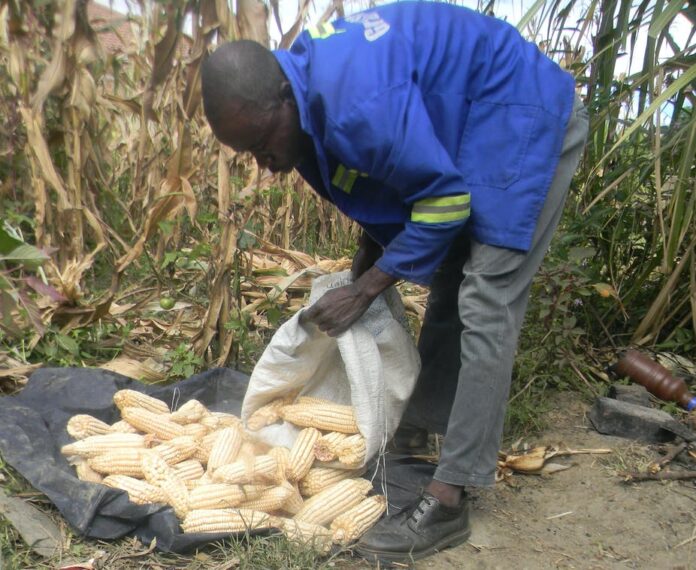Staff Writer
Food security in Zimbabwe is expected to improve significantly as the country anticipate a bumper harvest after the 2020/2021 agricultural season, the UN Food and Agriculture Organisation has said.
In its latest Global Information and Early Warning System on Food and Agriculture, FAO, however, expressed concern over access to food due to inadequate households’ incomes.
According to the IPC acute food security analysis, about 3.4 million people were assessed to be in need of humanitarian assistance in the January-March 2021 period, about one million people less than the estimate of the same period in the previous year.
Zimbabwe faced multiple shocks in recent years, including drought-reduced agricultural outputs and severe macro-economic difficulties.
“These factors reduced households’ food availability and impinged on their access to food throughout 2019 and 2020. The negative effects of the COVID-19 pandemic aggravated conditions, particularly with regard to income levels due to market instability from COVID-19 lockdown measures.
“The expected large harvest in 2021 is anticipated to significantly improve households’ food supplies and to result in a decrease in the number of people needing assistance in the second and third quarters of the year. viagra pour filles
“There are still significant concerns regarding access to food, as households’ incomes are not foreseen to recover significantly, reflecting the overall poor economic growth prospects, while food prices are anticipated to remain at high levels despite likely seasonal declines in the coming months.”
Harvesting of the 2021 cereal crops has begun and production is officially estimated at a significantly high level, following two years of weather-reduced outputs.
“Production of maize, the principal food crop, is estimated at 2.7 million tonnes in 2021, more than double the five-year average. The expected abundant harvest reflects both an expansion in the sown area, estimated at a well above-average level of 1.9 million hectares, and excellent yield prospects,” FAO said.
The UN agency said rainfall was well distributed since the statrt of the 2020/2021 agricultural season in October last year while cumulative levels between October and April were average to above average.
“As a result, in April, values of remote sensing vegetation indices in cropped areas were near the ten-year highs, affirming expectations of high crop yields.
“The widespread distribution of subsidized agricultural inputs, mostly fertilizers, through government programmes, including the Presidential Input Scheme that targeted about 1.8 million smallholder farmers, have further reinforced the good yield prospects.
“However, a decline in rainfall amounts in late March and early April, coupled with localized outbreaks of locusts and other pests (including Fall Armyworms) in southern districts, could result in a small downward revision to the current production estimate.”
Outturns of other cereal crops, including sorghum and millet, are also estimated to increase steeply in 2021 and surpass the five-year average levels, FAO noted.
“Overall, on account of both the large planted area and good yield prospects, total cereal production is foreseen to rebound significantly to a level of over 3.2 million tonnes in 2021, well above the short-term average,” the UN agency said.
FAO also said grain import requirements in the 2021/2022 marketing season would fall to almost negligible levels – well below the five-year average quantity of 400 000 thousand tonnes – based on the expected strong rebound in maize production.
“In addition, national stocks are also expected to increase substantially to an above-average level. Imports of wheat and rice, which are produced in smaller quantities compared to maize, are forecast at near-average levels,” FAO said.
The official monthly food inflation rate was estimated at 1.7 percent in April, lower than March’s level and the exceptionally high rates registered in mid-2020, when it peaked at 38 percent.
“The slowdown in price increases partly reflects the relative stability of the official exchange rate since the last quarter of 2020 that has helped to temper imported inflation as well as the large quantities of grain imports, which have shored up domestic supplies.
“However, on a yearly basis, food prices remained significantly high and the overall annual inflation rate was estimated at 217 percent in April 2021, mostly reflecting the effects of a generally weak currency, rapid growth in money supply and poor harvests in 2020 and 2019 that caused a tight supply situation.”
The expected bumper harvest comes at a time government has moved to battle post-harvest losses including provision of equipment and storage facilities to ensure maximum beneficial to the productive season.
Zimbabwe requires at least 1,4 million tonnes of maize for human consumption yearly and 350 000 tonnes for stock-feed.











